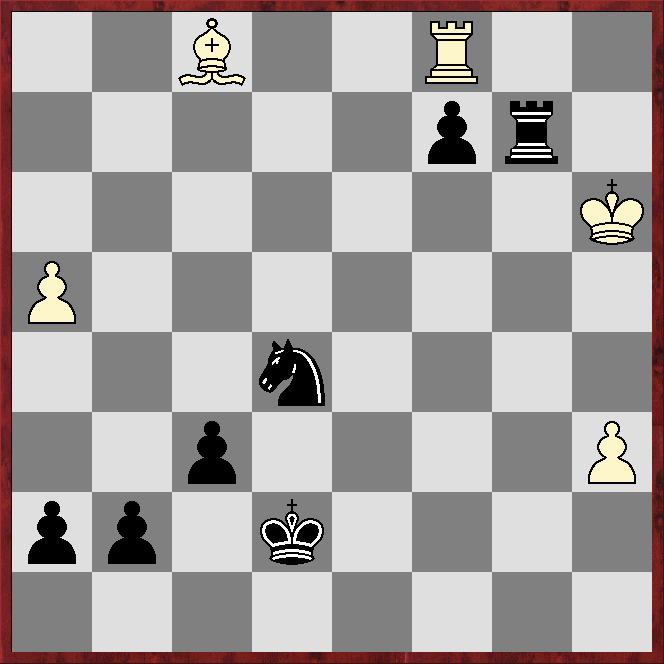Michaël Dittmar (1808) - Spanton (1937)
Scotch
1.e4 e5 2.Nf3 Nc6 3.d4 exd4 4.Nxd4 Bc5 5.Nb3
I can remember when this used to be the main continuation, but today it lags well-behind 5.Be3, and probably also 5.Nxc6. However, in ChessBase's 2025 Mega database it scores two percentage points better than the other two moves.
5...Bb6 6.Nc3 Nf6 7.Qe2!?
This looks strange at first, but it scores 57% in Mega25, the idea being to quickly castle long and attack on the kingside.
*****
*****
*****
*****
7...0-0!?
Castling into it? Maybe, but it is hard to believe Black has made a mistake in the preceding moves, so unless short castling is itself a mistake, this must be satisfactory.
8.Be3
Slightly more popular in Mega25 is 8.Bg5, when the main line runs 8...h6 9.Bh4 a5!? 10.a4 Nd4 11.Qd3 Nxb3 12.cxb3 c6 13.0-0-0, with a slight edge for White, according to Stockfish17 and Dragon1.
8...Re8 9.f3 Qe7?!
This takes away support for the move ...d5, which is probably what Black should be prioritising. With that in mind, the engines suggest 9...Ne7!?, while most popular in Mega25 is the immediate 9...d5!?, when the main line runs 10.0-0-0 d4 11.Bg5 Be6, reaching a position the engines at first reckon favours White, but which they come to rate as equal.
10.0-0-0 d6
*****
*****
*****
*****
11.Kb1!? Be6 12.h4?!
Apparently a novelty, and probably not a good one. Nenad Ferčec (2460) -Tamás Fodor Jr (2502), Pula (Croatia) 2012, went 12.g4 Ne5? (better is 12...Nd7, according to the engines) 13.Nd4 Bc4?! 14.Qg2 Bxf1 15.Qxf1 Bxd4 16.Bxd4 Ng6 17.h4, when the engines reckon White is winning (but ½–½, 39 moves).
12...d5!?
It has taken two tempi to get there, but if the move is sound, it should just about equalise. Dragon1 reckons it is the best move, but Stockfish17 fluctuates between the text and 12...Rad8.
*****
*****
*****
*****
13.Bxb6
There is nothing in 13.exd5 Nxd5 14.Nxd5 Bxd5 15.Bxb6 axb6 16.Qxe7 as Black has 16...Nxe7 - but not 16...Rxe7? 17.Rxd5 Re1+ 18.Nc1 Nb4 as White has 19.Rd7 Nxa2 (19...Rxa2?? 20.Rd8+ Re8 21.Rxe8#)) 20.Bc4! Rxh1 21.Bxa2!
However the engines give 13.Bg5!? d4 14.Na4 h6!? 15.Qe1!? Qd6!? with an unclear position that may slightly favour White.
13...axb6 14.g4?
This is definitely bad, but playable is 14.e5!? Nh5 15.Qf2, when 15...Nxe5 wins a pawn, but White has decent-looking compensation and certainly practical chances. However, simplest is 14.exd5 Nxd5 15.Nxd5 Bxd5, which reaches the same equal position as in the first note to White's 13th move.
14...dxe4 15.Nxe4 Nxe4
Even stronger is 15...Bxg4!, one point being 16.Nxf6+ can be met by 16...Qxf6.
16.Qxe4 Bxb3 17.cxb3!?
The engines like this way of recapturing.
17...Qxe4+ 18.fxe4 Rxe4 19.Rg1?!
The engines strongly dislike this, preferring 19.g5.
19...Rae8 20.Bc4 Ne5?!
Probably best is 20...Kf8, unpinning the f pawn and negating back-rank mating threats.
21.Bd5 Rxg4 22.Rxg4 Nxg4 23.Bxb7
*****
*****
*****
*****
Black has an extra pawn and the better pawn-structure. But White has the better minor piece for cooperating with a rook and for playing with rival pawn-majorities. The engines reckon Black has the upper hand (Dragon1) or at least a slight edge (Stockfish17).
23...Ne5
The engines suggest sorting out the back-rank problems with 23...Kf8, 23...g6 or 23...h6.
24.Bg2!?
White should probably immediately set about creating a passed pawn, starting with 24.a4.
24...f6 25.b4 Kf7 26.a4 Ke7 27.a5 bxa5?!
Probably better is 27...c6.
28.bxa5 c6
 |
| White is still a pawn down, but no longer has doubled pawns and has the much more advanced passer, leading the engines to call the position completely equal |
*****
*****
*****
*****
29.Ka2
Not 29.b4? Rb8 30.Rd4 c5 etc.
29...Rb8 30.b3?
But now 30.Rd4 was fine, as was 30.a6 (30...Ra8 31.Bf1).
But now 30.Rd4 was fine, as was 30.a6 (30...Ra8 31.Bf1).
30...Rb5 31.b4
Best, but White is losing a second pawn.
31...Rxb4 32.Ka3 Rb7
After 32...Rxa4? 33.a6 Black is struggling for a draw (but should get it, according to the engines), while 32...Rb5 33.Ka4 Nc4? (better is 33...Rb2, transposing to the same position as in the game's 33...Rb2) 34.Bxc6 Rxa5 35.Kb4 Rh5 36.Kxc4 Rxh4+ is also equal, according to the engines, but with plenty of play in the position with Black's rook and three pawns battling White's rook and bishop.
33.Ka4
Possibly slightly better is 33.Bf1.
33...Rb2!? 34.Bf1 Ra2+ 35.Kb4 c5+ 36.Kb5
Hopeless is 36.Kxc5 Rxa5, after which White has no compensation for being two pawns down. Indeed, with all remaining pawns on one side of the board, the knight is probably the better minor piece despite the presence of rooks.
36...c4 37.a6 c3 38.Rc1 Rb2+ 39.Ka4 Kc2
*****
*****
*****
*****
40.Ka3?
White needed to move the bishop, while keeping it covering the a pawn, so both 40.Be2 and 40.Bb5 draw, according to the engines, but 40.Bg2?? loses to 40...Ra2+ 41.Kb5 Nd3 etc.
*****
*****
*****
*****
40...Rb1!
The only winning move, although at first glance it may seem as if Black cannot stop the a pawn. but that is not so.
41.Rxc2 Rxf1 42.a7 Ra1+ 43.Ra2 Nc4+
The move MD missed.
The game finished:
44.Kb3 Rxa2 45.Kxa2 Nb6 46.Kb3 Kd6 0-1






No comments:
Post a Comment